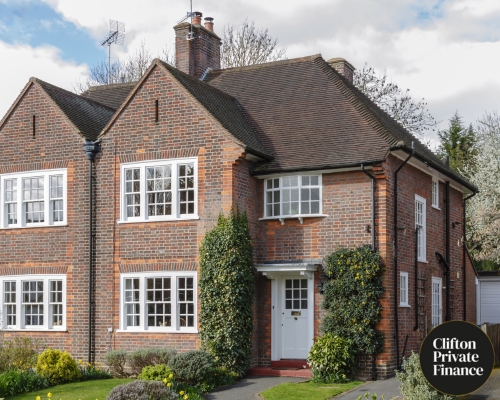Categories
Are Bridging Loans a Good Idea?

Bridging finance has become a popular funding solution in the last decade, but are bridging loans a good idea?
A bridging loan can be a good idea depending on what kind of property finance you need, for how long, and whether you have a solid exit strategy in place.
In this guide, we explain what bridging loans are, how they work, and their pros and cons, and we provide lots of examples so you can be confident in deciding if a bridging loan is right for you.
Written by: Sam O'Neill & Sam Hodgson
Skip to:
When are Bridging Loans a Good Idea?
How Bridging Loans Differ From Mortgages
The Pros and Cons of Bridging Loans
How to Qualify for a Bridging Loan
When are Bridging Loans a Good Idea?
Bridging loans can be a good idea in certain situations where there is a temporary need for funds before a more permanent financing solution can be arranged.
Some examples of this are:
- Buying a house before you sell your current property
- Buying a house at auction
- Renovation or refurbishment
Bridging loans tend to have higher interest rates than mortgages, but they can also offer more flexibility. They're also short-term, so if you pay your bridging loan early, you'll typically only pay interest for the months you had the bridging loan.
How Do Bridging Loans Work?
In a nutshell, a bridging loan is a short term finance solution for buying a property.
They typically span a 12-month term – although they can be more flexible given the need and depending on the lender.
Many people find bridging a great solution when traditional finance, like a mortgage, is not an option for them.
As the name would suggest, bridge loans assist in 'bridging the gap' between selling and buying property. Alternatively, you may find bridge loans useful when financing renovations, buying a property at auction or investing in property development.
Naturally, bridging can be applied to myriad scenarios, but its most common usage is buying a new property before your previous home has sold.
How Bridging Loans Differ From Mortgages
The main difference between the two is that a mortgage is a long-term loan while a bridging loan is short term.
Mortgages are typically used to purchase a property outright for the long term while bridging loans are often used to secure a property quickly in the short term before refinancing later down the line.
Like most short term loans, bridging finance usually comes with higher interest rates and additional fees, so they’re typically designed to be held for only 12-18 months.
The key difference, and a great selling point, for bridging loans is how repayments and interest rates function.
With a bridge loan, you don’t make monthly repayments towards the capital of your loan like you do with a mortgage.
Instead, you pay it off as a lump sum at the end of your term.
This is where your exit strategy comes in – how are you going to repay your loan?
Here are the most common type of bridging loan exits:
- Selling another property (your current home, for example)
- Selling the property you’ve bought with your bridging loan (after you’ve done some renovations, for example)
- Refinancing with a standard mortgage for the long term (perhaps you were buying at auction and needed to complete within the 28-day timeframe)
- Selling a separate property or asset altogether
- Any other expected large cash windfall (such as a pending inheritance, for example)
This convenience is also reflected in how the interest is charged on a bridging loan.
You often have the option to 'roll up' interest payments to the end of your loan term.
This means you don’t have to worry about making any repayments to your bridging loan for its entire term (which helps with moving costs or cash flow for your development project, for example), and you repay your loan and interest together when you have the funds.
You’ll also only pay interest up until you repay your loan, so if you can pay it back sooner than 12 months, you could save money.
A standard mortgage doesn’t allow this type of interest structure or early repayment.
Ultimately, bridge loans offer flexibility for those with experience but require a level of preparedness for those uninitiated – it’s important, and a requirement from lenders, to have a clear and robust exit strategy.
What Are the Types of Bridging Loans?
Aside from the most common use (bridging the gap between buying a property before yours sells), there are several different types and uses of bridge loans.
Here’s an overview of what bridge loans can be used for:
- Refurbishments - Bridging loans can be used to fund property refurbishments or renovations. This can be particularly useful for property developers and landlords who need to make improvements to a property in order to rent or sell it.
- Property development - Bridging loans can also be used to fund business ventures, such as purchasing a new commercial property or investing in property development or land purchase.
- Auction purchases – You will have only 28 days to finalise the purchase of a property bought at auction, therefore, bidders can make use of the fast financing a bridge loan allows for.
- To pay care home fees - care home fees can be expensive upfront, and you might need to sell a property that's no longer in use to cover the costs. But if the timings don't line up, a bridging loan can help.
- To pay inheritance tax (IHT) - it's common to have to pay a large IHT bill before you've received the money, so if you don't have the funds to hand, a bridging loan can fill the gap.
These are general uses that can apply to numerous scenarios, and the key takeaway is the flexibility with which bridge loans can be applied to your own circumstances.
Watch our video below for an example of how to fix a broken property chain with a bridging loan:

Sam O'Neill
Head of Bridging
Let us do all the hard work of finding the right bridging lender for your circumstances.
We secure bridging finance for applications of all types, and we negotiate competitive lending to meet your needs and timescale.
What Are the Costs of Bridging Loans?
The cost of a bridging loan depends on a variety of factors, including the amount of your loan, the length of your loan, and your lender.
Interest rates can vary from lender to lender and can be determined by your creditworthiness, the LTV (Loan-to-value), the type of loan you wish to take out and the value of the property (or properties) used as collateral.
In addition to interest, some of the other most common bridging loan costs include:
- Arrangement fee - A fee charged by the lender for setting up your loan and processing your application. This can be a percentage of your loan amount or a flat fee.
- Valuation fee - A fee the lender charges to have your property valued - typically a flat fee (Tip: our brokers try to prioritise lenders that accept online valuations to save you costs).
- Legal fees - Some lenders require you to pay your own legal fees, while others may include these costs in your loan.
- Exit fees - Some lenders charge an exit fee when you repay your loan, usually a percentage of your loan amount.
It's also worth noting that each lender has different fees, lending criteria, and varying interest rates, so it’s important to shop around and compare the costs of different bridging loans to find the most cost-effective solution. - Broker fee - most people use a finance broker, like us, to help them find a suitable and low-cost bridging loan, and a fee will apply.
Bridging Loan Calculator
Our bridging loan calculator is a valuable tool that helps simplify the process – it’ll work out an indicative quote and support the initial stage of finding out if bridging finance is the best option for you:
The Pros and Cons of Bridging Loans
Bridging loans can be a useful financing option for certain situations, but they also have their own set of pros and cons. Here are some of the main advantages and disadvantages to consider:
Pros:
- Speed of funding - Bridging loans can be approved and funded much more quickly than traditional mortgages, making them a good option for property buyers who need to move quickly.
- Flexibility - Bridging loans can be tailored to the borrower's specific needs, with options for open or closed loans, first or second charges, and more.
- No early repayment charges - Most bridging loans don’t carry any early repayment charges, meaning if a borrower can pay off the loan early, they can do so without incurring any additional costs.
- Unmortgageable property - Some properties that would not qualify for a traditional mortgage can be acceptable for a bridging loan – properties bought at auction, for example. You can then refinance later after developing the property.
Cons:
- Higher interest rates - Bridging loans typically come with higher interest rates than traditional mortgages.
- Short term - Bridging loans require the borrower to pay them off in a relatively short period of time, which can be a problem if a property doesn't sell as quickly as expected or if refurbishment and development plans exceed costs.
- Risk - If the borrower cannot pay back the loan on time, they could lose the property as collateral, meaning it can be a relatively high risk strategy without a level of preparedness.
- Fees - There are many fees and additional costs associated with bridging loans, such as arrangement fees, valuation fees, and more.
It's important to weigh these pros and cons and compare different options before applying for a bridging loan.
An experienced bridging broker can ensure you understand the terms and conditions of your loan and find the right lender and product suited to your circumstances.
How to Qualify for a Bridging Loan
Qualifying for a bridging loan can vary depending on the lender, as they’ll consider your application based on a variety of factors:
- Property - Most bridging loans are secured against a property, so the property will need to be valued and considered as worthy deposit against your loan.
- Purpose - The lender will need to know what your loan is intended for, such as buying a new property or renovating a property before selling. They will need to assess the project's feasibility before agreeing to lend.
- Exit strategy - Since bridging loans are short-term loans, the borrower must provide a solid repayment plan – typically, this comes through the sale of the property the loan is raised against, but it could be in the form of additional assets or other properties.
- Credit History - Borrowers typically need a good credit history to qualify for a bridging loan. This will include a minimum credit score and a track record of paying bills on time and managing credit responsibly. But if your credit score is poor, we may still be able to help you.
Related: Guide to finding the best bridging loans
How We Can Help
Bridging loans aren't typically offered by high street banks anymore, so it's likely you'll need a specialist lender. Each lender will have their own approach to assessing risk and the feasibility of each application.
At Clifton Private Finance, we have an award-winning bridging team dedicated to driving results. We have relationships with lenders across the whole bridging market and have access to the best deals. Our bridging brokers can guide you through the process and liaise with lenders on your behalf.
To see what we can do for you, call us at 0117 959 5094 or book a consultation below.


FAQs
Yes, a valuation is typically required for a bridging loan in the UK. Since bridging loans are often secured against a property or other valuable assets, lenders will want to assess the market value of the property being used as security. This helps the lender determine how much deposit they want you to provide based on the value and condition of the property. You can borrow up to £25m with bridging finance, but it’s typically capped at about 80% of the value of the property you’re using as security. It's important to note that different lenders have varying policies and criteria regarding the maximum loan amounts they offer for bridging finance. Some lenders have a maximum limit of over £1 million, while others may specialize in smaller loan amounts. Additionally, the terms and conditions of the loan, including interest rates and fees, should also be taken into consideration when determining the overall affordability of the bridging loan. Yes, you typically need a 20-40% deposit for a bridging loan. It can be possible to get a bridging loan without a deposit (a 100% bridging loan), but you’ll need other assets in the background to secure the loan against, and more stringent criteria and higher costs could apply. Yes, it is possible to get a 100% bridging loan (also known as a 100% LTV bridging loan), but it is rare. This means that you won’t need to put down a deposit and can borrow the full value of your property. However, the criteria for these loans can be hard to meet, and you’ll need to provide additional assets as security for your loan. Interest rates and fees can also be higher to compensate. While using bridging finance doesn’t technically make you a cash-buyer, it can allow you to act like one. Mortgages take months to process, often leading to an ‘onward chain’ where all parties involved need to wait for funds to be transferred. Bridging finance can usually be accessed a lot quicker than mortgages so you can bypass the onward chain, giving you an advantage over other buyers and being attractive to sellers. Bridging loans typically have a term of 12 months, but some lenders are willing to stretch their terms to 18 months, or even 2 –3 years depending on the case. Terms longer than 2 years will usually only be considered for specific cases. Yes, you can use a bridging loan to pay Stamp Duty. This amount could be covered by a bridging loan, providing you have a way to repay the additional borrowing amount to your lender. Yes, bridging loans are safe when they’re used in the right circumstances with a solid repayment strategy. However, we recommend speaking to a qualified advisor, like our brokers at Clifton Private Finance, before you take out a product. The main factors to consider with bridging finance are that the full loan amount will usually need to be repaid within a year, and like a mortgage, it is secured against a property as collateral. This means that in the case that you aren’t able to repay your bridging loan, your property would be at risk of repossession. But with a watertight exit strategy, bridging finance can be an efficient way to secure property quickly. Bridging loans are designed to be short-term so there’s no maximum age limit when applying for a bridging loan. This does depend on the lender, as some bridging lenders do have an upper age limit, but there are lenders on the market who offer bridging loans for borrowers aged 70 and over. Bridging loan interest rates usually range between 0.45% - 2% per month, depending on the case and the market rate. Unlike mortgage interest rates, bridging loan interest is calculated monthly instead of yearly. This is because bridging loans are short-term and, in many cases, repaid within a year. Bridging loans can be arranged without early repayment penalties, so interest is calculated monthly to ensure you only pay interest on the months you have the loan for. Unfortunately, mainstream banks in the UK don’t offer bridging loans. This means that if you’re looking for a bridging loan, you won’t be able to get one using a lender you’d find on the high street. There are a variety of specialist lenders that offer bridging loans, but because these lenders are smaller and more niche, you may need a bridging broker to access them. Banks typically charge two main fees when taking out a bridging loan – arrangement fees and interest. But there are other costs to consider such as valuation fees, broker fees and administration fees. Costs can vary from lender to lender, and will also depend on what your bridging loan is for (e.g., residential or commercial purposes.) Arrangement fees are what the lender charges you to take out the loan and can range between 1.5 - 3% of your overall loan. Bridging loan interest, on the other hand, is calculated monthly. This can catch borrowers out who may be expecting an Annual Percentage Rate (APR) like with a mortgage. Yes, you can convert a bridging loan to a mortgage through refinancing, and it is common among borrowers who use bridging finance to buy residential properties. However, whether or not you’ll be able to refinance to a mortgage is dependent on your financial circumstances, the lender, and the property you’re planning to buy. It’s important to be sure that refinancing is a viable repayment option before you take out a bridging loan on a residential property. Yes, bridging loans are typically more expensive than mortgages. Bridging loan interest rates can be much higher than a mortgage, and are calculated and displayed as monthly rates instead of the usual annual percentage rate (APR) that you’ll see on a mortgage. However, bridging loans are a short-term solution, and you’ll only pay interest on the months you’ve borrowed money for – and you can repay early without any charges (for most loans). There are many circumstances where bridging loans are an affordable option and a means to an end - for borrowers that need to finance a property purchase quickly, it may be the only option available. The two most common ways to pay a bridging loan are to sell a property or refinance to a mortgage. You may also need to ‘service’ the loan through the term, which means paying the interest monthly. However, you can opt to ‘roll up’ your bridging interest to be repaid at the end along with the capital. There are also other ways to repay a bridging loan, such as selling a business or even using money from an inheritance. The method in which you pay your bridging loan can be flexible, just as long as it is clear in your application that you have a surefire way to repay your loan when the terms are up. In most cases, a bridging loan will require a minimum deposit of 25%. However, the minimum can vary depending on the lender and the specific circumstances of the loan itself. Generally, bridging loans are secured against a property or other valuable assets, and the deposit required is often expressed as a percentage of the property's value, known as the loan-to-value ratio. In some cases, 0% deposit bridging loans are an option, but only if you have other property or assets in the background to provide additional security. No, typically, you’ll repay a bridging loan in one chunk at the end of the loan term. Bridging loans are a form of short-term finance and will usually need to be repaid within 12 months, but there can be room for flexibility. In some cases, borrowers may be required to make monthly interest payments. This means that each month, you would pay the interest accrued on the loan amount while the principal amount remains outstanding until the end of the loan term. But usually, the interest is "rolled up" or added to the loan balance and paid with the rest of the loan at the end of the term. This option can help protect your cashflow so you can spend it on moving costs or refurbishments, for example. Bridging loans can be arranged in as little as 7 working days. However, it depends on the complexity of the bridge loan and your specific circumstances. It may also be more expensive for you to rush an urgent application through – but not impossible. Bridging loans are a popular option for borrowers who are under time constraints, such as buying a property at auction or breaking a chain. The key factors lenders tend to consider are: Security - Bridging finance is usually secured against property or other valuable assets. Lenders will assess the value and marketability of your security. Exit Strategy - Lenders will want to understand how you plan to repay your bridging loan. In most cases, this is selling your old property, selling the new property (flipping), or refinancing with a long-term mortgage. Loan-to-Value (LTV) Ratio - Lenders consider the loan amount compared to the value of the property being used as security as a percentage. The LTV ratio can vary, but most lenders will have a maximum of 60-80% LTV. Remember, the criteria for obtaining bridging finance in the UK can vary depending on the lender and your circumstances.
Do you need a valuation for a bridging loan?
How much can you borrow with bridging finance?
Do you need a deposit for a bridging loan?
Can I get 100% bridging finance?
Does a bridging loan make you a cash buyer?
What is the longest bridging loan term?
Can I use a bridging loan to pay stamp duty?
Are bridging loans safe?
Can an 80 year old get a bridging loan?
What is the monthly interest rate on a bridging loan?
Do banks still do bridging loans?
How much do banks charge for bridging loans?
Can you turn a bridging loan into a mortgage?
Is a bridging loan more expensive than a mortgage?
How are bridging loans paid?
What is the minimum deposit for a bridging loan?
Do you pay monthly payments on a bridging loan?
How long does it take for a bridging loan to come through?
What is the criteria for bridging finance?










.png)

